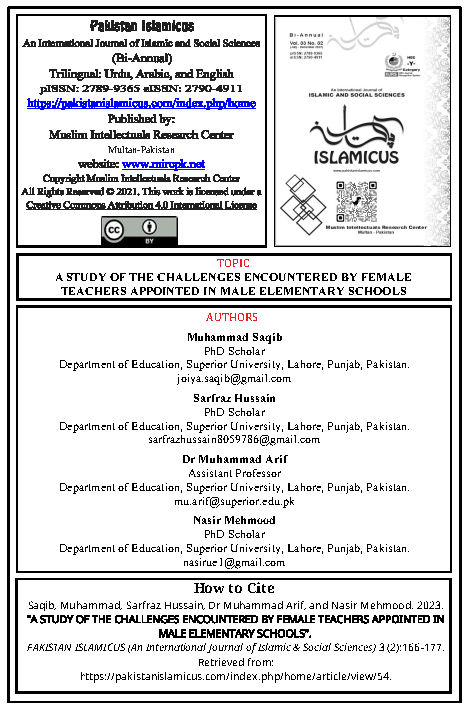A STUDY OF THE CHALLENGES ENCOUNTERED BY FEMALE TEACHERS APPOINTED IN MALE ELEMENTARY SCHOOLS
Keywords:
Job Satisfaction Level, Social Problems, Female Teachers, Male Teachers, Elementary SchoolsAbstract
Men and women are always two sides of the same coin, each possessing unique qualities and approaching situations in their own distinct ways. Although possible, a male practitioner can think about fluttering, but still, it is disciplined in the eyes of a talented holder. We are living in a society where everyone expects female nurses and teachers to treat and educate women, but unfortunately, there is a prevalent dislike and resistance towards allowing our own females to participate in education. This research examined one aspect of this educational system which is the problem of female teachers in lower Punjab. This study explored the social problems of these teachers, the level of their job satisfaction, the level of their confidence, and their performance. The population of this study consisted of all the Elementary school of Southern, Punjab Pakistan which has female staff in male Elementary school. The sample was comprised, of 200 female teachers. In non-probability, sampling convenient sample was used. Questionnaires were developed to know their views on the current situation. The value of Cronbach's alpha was 0.750, which shows a high level of reliability of the scale (questionnaire). In our conservative society female teachers face problems appointed in male schools but this study result shows that female teachers are satisfied with their appointment. All the females/participants in this study gave free responses through a questionnaire they are happy to work with male teachers.
References
Abel, M. H., & J. Sewell. (1999). Stress and burnout in rural and urban secondary school
teachers. The Journal of Educational Research, 92: 287–293.
Almekhlafi, A.G., & Almeqdadi, F.A. (2010). Teachers' perceptions of technology integration in the United Arab Emirates school classrooms. Journal of Educational Technology & Society, 13(1): 165.
Amjad, N. & S. Qasim. (2013). Job Satisfaction among female teachers in public and
private sectors. Int. J. Applied Res. 2: 88-97.
Beer, J., &J. Beer. (1992). Burnout and stress, depression and self-esteem of teachers.” Psychological Reports, 71: 1331-6.
Bock, R.D., & R.J. Mislevy. (2002). Adaptive EAP estimation of ability in a microcomputer environment. Applied Psychological Measurement, 6: 431–444.
Caprara, G.V., C. Barbaranelli, P. Steca. & P.S. Malone. (2006). Teachers’ self-efficacy beliefs as determinants of job satisfaction and students’ academic achievement: A study at the school level. Journal of School Psychology, 44: 473–490.
Csikszentmihalyi, M. (1990). Flow: The Psychology of Optimal Experience (New York: Harper and Row).
Evans, L. (2001). Delving deeper into morale, job satisfaction, and motivation among education professionals. Educational Management and Administration, 29: 291–306.
Farooq, M.S., N. Feroze, & Y.T. Kai. (2017). An Analysis of the Problems Faced by Female Primary School Teachers in District Muzaffarabad. International Journal of Research in Humanities and Social Studies, 4(11), 31-32.
Greller, M. M. (2006). Hours invested in professional development during late career as a function of career motivation and satisfaction. Career Development International, 6: 544–559.
Jordan, D. (1999). A Correlational Analysis of School Leadership and Organizational Climate with Students’ Classroom Achievement (Beaumont, TX: Lamar University Press).
Khan, A.S. (2011). To Investigate the Sense of Teacher Efficacy between Male and Female Teachers of Secondary Schools of Wah Cantt. Language in India, 11(3): 102-105.
Martin, A.J., K. Linfoot. & J. Stephenson. (1999). How teachers’ respond to concerns about misbehaviors in their classroom. Psychology in the Schools, 36: 347-358.
McGee, R., P.A. Silvea & S. Williams. (1999). Parents’ and teachers’ perceptions of behaviour problems in seven-year old children. The Exceptional Child, 30: 151-161.
Nadeem, M.M.S. Rana, A.H. Lone, S. Maqbool, K. Naz & D.A. Ali. (2011). Teacher’s competencies and Factors Affecting the Performance of Female Teachers in Bahawalpur (Southern Punjab) Pakistan, I.J.B.S.S, 2(19): 101-104.
Poulou, M., & B. Norwich. (2000). Teachers’ causal attributions, cognitive, emotional and behavioural responses to students with emotional and behavioural difficulties. The British Journal of Educational Psychology, 70: 559-582.
Steele, J.L., & K.P. Boudett. (2009). The collaborative advantage. Educational Leadership, 66(4): 54–59.
Supovitz, J. A. (2002). Developing communities of instructional practice. Teachers College Record, 104(8): 1591–1626.
Traynor, P., (2003). Factors contributing to teacher choice of classroom order strategy. Education, 123: 586-563.
Vescio, V., D. Ross. & A. Adams. (2008). A review of research on the impact of professional learning communities on teaching practice and student learning. Teaching and Teacher Education, 24(1): 80–91.
Williams, C.L. (1992). The glass escalator: Hidden advantages for men in the “female” professions. Social problems, 39(3): 253-255.
Zimmer, L. (2000). Tokenism and women in the workplace: The limits of gender-neutral theory. Social problems, 35(1): 64-65.

Downloads
Published
Issue
Section
License
Copyright (c) 2023 PAKISTAN ISLAMICUS (An International Journal of Islamic & Social Sciences)

This work is licensed under a Creative Commons Attribution 4.0 International License.
This work is licensed under a Creative Commons Attribution 4.0 International License.

































